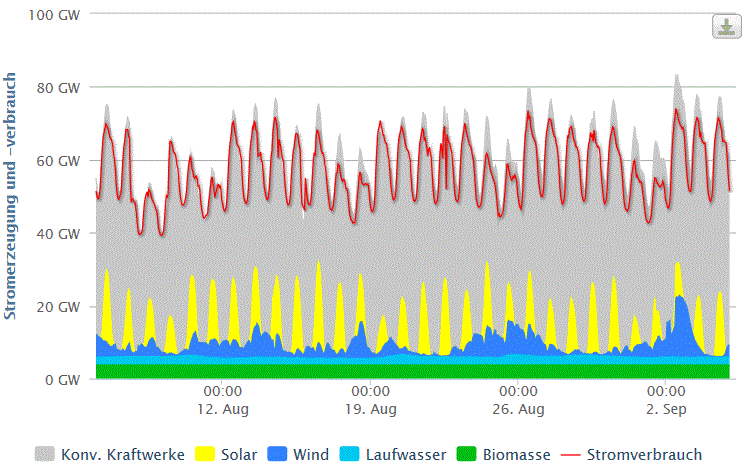Germany’s renewable energy feed-in act, the EEG, forces power grid operators to buy up all renewable energy produced in Germany and to feed all of it into the power grid, whether it is needed or not. The aim is to squeeze out the fossil fuel energy that’s fed in. The problem however is that wild, unpredictable fluctuations in the supply of wind and solar energy often lead to huge, uncontrollable grid overloads.
The print edition of the Handelsblatt described in a feature titled “Energy Madness” how the absurd Germany’s energy feed-in act has become. Hat-tip: Hans Labohm here. He quotes the Handelsblatt:
For the green energy branch, Sunday June 16 was a special day to celebrate. The sun shone for hours and a strong northwest wind blew across Germany. At 2 p.m. solar panels were sizzling with power and the wind turbines up north were turning strongly. Green energy was being fed into the power grid to the tune of 29,600 megawatts, and so provided 61% of the power demand. Never before had Germany’s power supply been so green.
However, the employees of the power grid operators were far less inclined to celebrate. As is the case every Sunday, the demand for power was relatively small. And as mandated by the renewable energy feed-in act, they were required to somehow get all the solar and wind power to the consumers. After all, green power has the right of way in the power grid. This meant gas-fired power plants had to be shut down, and Holland, Czech Republic and Poland had to accept, against their will, the excess German solar and wind power.
Power customers in the industry were delighted with all the green power on June 16: They could consume as much power as they wanted – and were credited with cash for doing so. One chemical concern that was able to take in more power between 2 – 3 p.m. than thought, did not have to pay the usual 30 to 60 euros per megawatt-hour. No, instead the company got more than 100 euros. The important thing was to somehow get the power out of the grid.
This is a story from Absurdistan, from the land of the Energiewende.”
Large companies with energy gobbling equipment are paid 100 euros for every megawatt they can burn. I guess they switch on as many of their huge furnaces, kilns or whatever and run them empty at full blast. Just burn off as much power as you can! – and get paid to do it.
Just the opposite is demanded in the dead of winter when there is no sun and when the wind dies down. During the week, energy demand soars and their is often not enough supply to meet the demand. And because many power companies are finding it unprofitable to run conventional systems part-time, many are simply mothballing such plants completely, thus making supply even rarer. As a result, the risk of blackouts is becoming a real increasing threat in Germany with each coming winter.
The chart that follows shows German power supply and consumption over the last 30 days. Solar energy is shown in yellow and wind in blue. Gray represents the conventional supply and the red line is the total demand. Often wind and sun spike and excess power needs to get dumped quickly…somehow, somewhere.
Chart source: www.agora-energiewende.de/
Note all the wild fluctuations, and so it is necessary to always have conventional power on stand by for calm sunless days.
Little wonder that the Handelsblatt, once a huge proponent of alternative energies, now calls it “energy madness”. Climate activists and greens, however, claim it’s a model for the world.






I think your government should mandate that all factory and office workers work on all sunny and breezy days. Take your holiday time in the winter. Special bonus – the risk of developing skin cancer will plummet!
How come Holland, Poland and the Czech Republic go along with the madness? I don’t imagine that they willingly put their energy grids at risk of cascading black-outs.
Poland is installing phase shifters at the border connectors to Germany to be able to selectively reduce the amount of energy flooding into their grid.
I think an interesting graph would be to see the fluctuation after subtracting the “green” energies from demand. How does the “rest demand” look like? Are the spikes attenuated or even worse? It is not easy to get the understanding from the contained graph.
Is it just me or is the Agora site indicating several GW of solar power generation at midnight for everybody?
[…] mycket ansedda tidningen Handelsblatt har skrivit en kritisk artikel (diskuterad här). Även när solen skiner och vinden blåser så blir det problem. Tidningen tar söndagen den 16 […]
[…] Yesterday I wrote 2 posts on the renewable energies folly in Germany, see here and here. […]